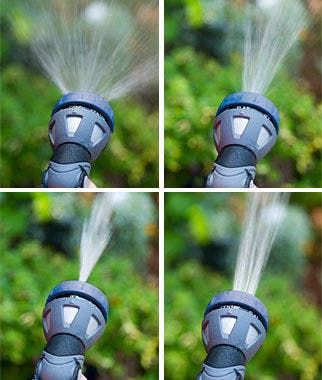We use cookies to give you the best experience on our website. These cookies are completely safe and secure and will never contain any sensitive information. Please read our Privacy Policy. By clicking "Ok" or clicking on any other content, you agree that cookies can be placed.
Effective watering techniques - soaker hoses, overhead watering, and drip irrigation

A landscape has different areas which all need watering in summer to keep them healthy. The different areas such as a lawn, vegetable bed, or perennial bed all need water to be delivered effectively which requires different watering techniques for each. Critical to all watering is to get water to the root zone of the plants rather than just the surface. If this is done effectively, by watering deeply each time, you can reduce the number of times you need to water.
Overhead Watering
This is the simplest system and is good for large open areas such as a lawn. Each blade of grass needs to receive water and the fine spray of an overhead or circular sprayer works well to create effective watering. Unfortunately, if you water at midday or in full sun, much of the water you send out to the grass evaporates before it hits the ground, so try to time your water for early in the morning, or at the end of the day. Using this type of watering in the perennial or shrub garden gets water onto the leaves of the plants rather than the root zone where it is most beneficial. The prime benefit of these systems is that they are portable and can be easily taken from the lawn to the vegetable bed or perennial bed in minutes.
Watering with Soaker Hoses
Soaker hoses, or leaky hoses as they are sometime called, rely on water seeping though the porous wall of the hose. The slow leak allows water to be delivered along the length of the hose and a few inches in the surrounding area. These hoses are great for perennial beds where you have a mass of plants all needing water but they are in a random pattern through the garden. The hose is flexible and can serpent through the bed delivering water to the root zone of the plants along the way.
Soaker hoses can be buried under mulch to keep the garden looking neat, and are attached to a regular hose and faucet so can be set to run on a timer. Remove and check the hose at the beginning of each new garden year to see if you have holes gushing water along the hose. A few holes can be mended with duct tape, but eventually you will need to replace the soaker hose. Alternatively, you can make a homemade soaker hose by punching a few holes in an old garden hose, but this is not exactly ideal for effective watering as there is little control over the water pressure when compared to something like a drip line.
Self-Watering Seed Starting Kits
Want to start your garden out on the right foot? We carry a variety of seed starting kits at Burpee that are self-watering and come in a variety of sizes.
Drip Irrigation and Drip Line Watering
 Soaker hoses are great when your annuals and perennials which are close together, but to effectively water shrubs and trees, you need something that delivers water to each one and not necessarily the ground between them. Unlike soaker hoses, drip irrigation allows you to send water along a sealed hose until it gets to the area where your plants are. A side shoot takes water just to that one plant. This is a particularly good watering method for shrubberies and containers where the items are well spaced and offers immense control for watering individual plants throughout your garden.
Soaker hoses are great when your annuals and perennials which are close together, but to effectively water shrubs and trees, you need something that delivers water to each one and not necessarily the ground between them. Unlike soaker hoses, drip irrigation allows you to send water along a sealed hose until it gets to the area where your plants are. A side shoot takes water just to that one plant. This is a particularly good watering method for shrubberies and containers where the items are well spaced and offers immense control for watering individual plants throughout your garden.
Hose and Wand Watering
Hanging baskets and containers that are spread widely apart are best dealt with by using a simple hose and wand arrangement. The hose delivers the water to the wand which has a trigger action. Flow of water can be adjusted from a light mist to a stream of water depending on what your plants need.
Utilizing a mixture of these watering techniques will ensure that your entire garden is watered effectively without any excess or waste.



